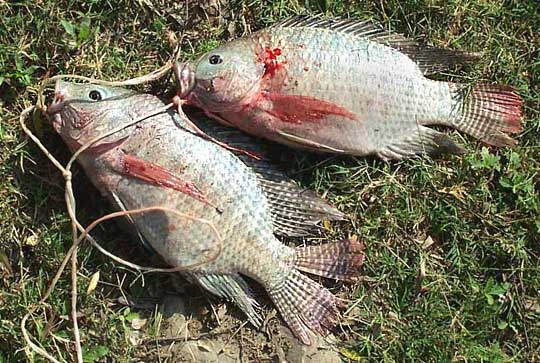Excerpts from Jim Conrad's
Naturalist Newsletter
from the April 28, 2007 Newsletter issued from Sierra Gorda Biosphere Reserve, QUERÉTARO, MÉXICO
MOJARRA THE AQUATIC CHICKEN
Last Sunday morning a little after sunrise I was down below the dam's overflow sluiceway atop a limestone rock next to a little pond that was emerald green with algae. It was a peaceful, lush oasis surrounded by steep, scrubby slopes heating up fast. Cicadas droned on and on upslope.
Then two young men, Marciel and Ernesto, emerged from behind some bushes carrying two fish on a string, which they lay on the grass next to me. The fish, whose tails were attractively banded, differed from carp or bass in that their top fins, the dorsal fins, arose right behind their heads and ran continuously almost all the way to their tails, where they were actually at their longest. I asked Maraciel if the fish were tilapia. He looked a bit confused and said that they were Mojarra (mo-HARR-ah, the rr trilled). You can see the two fish lying in the grass next to me below:

When I got back to my computer I compared my picture with what I could find with Google and figured out that both Marciel and I had been right, for the Spanish name for the fish is Mojarra Tilapia. They're TILAPIA NILOTICA.
This is a famous species, nowadays grown worldwide in prodigious numbers and sold in so many restaurants that they're sometimes called "aquatic chickens." Native to eastern Africa, development agencies such as USAID and the World Bank have pushed so hard for the spread of tilapia farming that now the species is grown in more than 85 countries. Because big money is involved there's so much hype about the species that you don't know what to believe.
Interesting points made at the above site are that Tilapia nilotica is 98% vegetarian, can live in either fresh or brackish water, can thrive on agricultural waste, and grow rapidly in hot temperatures. They must be tough fish to do so well in the alga-green pool below the dam where the oxygen level surely drops low at night, and I'll bet that there's plenty of agricultural chemical runoff in the water, too. Environmentalists are concerned that in warm areas introduced and escaped tilapia may crowd out native species.
As I took my picture Marciel stripped to his shorts and waded into the water. Briefly he submerged and came up with a string of four more Mojarra Tilapias, which earlier he'd tied to an underwater tree stump for safe keeping. Then he waded to another submerged stump and came up with yet another string. You can see what Marciel looked like emerging with his fish below:

Marciel says that our reservoir is full of tilapia, carp, bass, catfish and trout, all introduced species. I'd always considered this area as too hot for trout but if you look closely at the string in Marciel's right hand (our left) you'll see a fish he called trucha, which is trout, and it sure does look like a Rainbow Trout.
Marciel explained that late Saturday he'd strung a gillnet across the pond. Fish try to get through the net, can't make it, start backing out, but can't, and get the net stuck in their gills.
When Ernesto started walking away carrying the strings one string came undone, his catch plopped onto the ground, and his biggest tilapia flopped into the water and swam away. I was glad for the tilapia but when I saw the look on Ernesto's face I felt sorry for him, too.